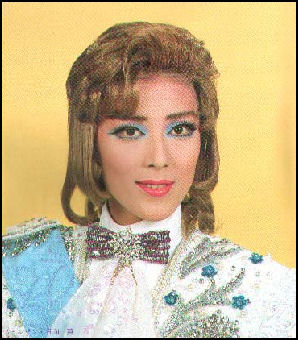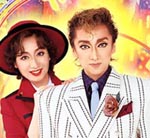TAKARAZUKA REVUE

Tale of Genji The Takarazuka Revue is an all-female musical theater company based in Takarazuka, Hyogo Prefecture, near Osaka and Kobe. Women play all the roles in stylized, super-melodramatic productions of things like “Gone with the Wind, Guys and Dolls” and “The Rose of Versailles”. Owned by Hanku Railroad, it was founded in 1913 by Ichizo Kobayashi, a struggling railroad businessman who thought an all-female revue would draw customers to his railroad line and a new resort he opened a the end of the line. [Source: Hilary E. MacGregor, Los Angeles Times]
Dr. Jukka O. Miettinen of the Theater Academy Helsinki wrote: One of the specialties of Japanese 20th century theater is the famous Takarazuka Revue. Its headquarters is in the city of Takarazuka, near Osaka. There is both the Takarazuka Grand Theater and the Takarazuka Music School, in which all of its present 400 actresses have been trained under strict, almost military discipline. The specialty of the Takarazuka Revue is that all the actresses are young, almost teenage girls. They also perform the male roles. This was a sensational novelty when the institution was founded in 1913. It was the brainchild of Kyobashi Ichizo, who founded a railway line to the city of Takarazuka. To attract passengers he also founded a hot-spring resort as well as an all-girl revue in the city of Takarazuka. [Source: Dr. Jukka O. Miettinen, Asian Traditional Theater and Dance website, Theater Academy Helsinki **]
All of Japan’s classical forms of theater are strictly male-dominated. Takarazuka turned the roles upside down when young, attractive girls with low voices appeared in the male roles. In this sense, the Takarazuka tradition can be compared with the Chinese yue opera, which evolved in the Shanghai region at the same time. Since the 1920s both forms have attracted huge, mainly female audiences. **
”
Good Websites and Sources: Takarazuka Review kageki.hankyu.co.jp ; English Site kageki.hankyu.co ; Revue Sphere shoujo.tripod.com/takara ; Good Photos at Japan-Photo Archive japan-photo.de ;
Links in this Website: NOH THEATER Factsanddetails.com/Japan ; KABUKI Factsanddetails.com/Japan ; BUNRAKU, JAPANESE PUPPET THEATER Factsanddetails.com/Japan ; KYOGEN, RAKUGO AND THEATER IN JAPAN Factsanddetails.com/Japan ; TAKARAZUKA, JAPANESE ALL-FEMALE THEATER Factsanddetails.com/Japan ; GEISHAS Factsanddetails.com/Japan ; GEISHAS AND THE MODERN WORLD Factsanddetails.com/Japan ; CLASSICAL JAPANESE MUSIC Factsanddetails.com/Japan ; JAPANESE FOLK MUSIC AND ENKA Factsanddetails.com/Japan ; DANCE IN JAPAN Factsanddetails.com/Japan

Takarazuka Theater and Company
Takarazuka is performed at two theaters: one in Tokyo and the other in Takarazuka (10 miles north of Osaka), where the troupe has been performing since it debuted with version of the Japanese folk tale “Momotaro” (“Peach Boy”). The originally rather modest Takarazuka Singing Troupe has grown in a century into a huge institution with over 400 actresses and some 1000 staff members. The Takarazuka troupes give performances at the Takarazuka Theater in Tokyo and often tour the United States and Europe. Altogether, the Takarazuka troupes give some one thousand performances to about two million spectators annually. **
The Takarazuka company is made up of around 470 members, all of whom are unmarried and graduated from Takarazuka’s affiliated training school, which is known for its strict discipline. The company in turn is broken into five troops’snow, Moon, Flower, Star and Cosmos — and a special troupe that showcases the most experienced actors, singers and dancers. The top star of each troupe plays the male lead. The five troupes take turns performing at the two venues and performing at other locations around Japan and the world, and are always joined by some members of the sixth group.
One former Takarazuka performer who got a staring role a musical told the Daily Yomiuri, “When I get on the stage with men — I mean, real men, not those played by by women — I become bewildered.
Rose of Versailles and Other Takarazuka Plays
The repertoire consists of two basic types of performances: revues and full-night musicals, especially written and composed for Takarazuka. Some of the plays are adapted from Western movies, some from popular Japanese comics. Plays derived from Western literature have also been popular, and so have Western musicals. As all the plays are highly romantic love stories it is natural that the Takarazuka style is both sugary-mellow and highly melodramatic. The dance technique is based on Western show dancing. In its semi-historical costuming and colourful stage sets the Takarazuka style has a highly romantic, fairytale-like character. **
In 2012, according to the Yomiuri Shimbun, Takarazuka did an adaption of Yoshiki Tanaka's novel Ginga Eiyu Densetsu (Legend of the Galactic Heroes). The science fiction epic is considered a classic in the Japanese space opera genre. Kaname Oki, who became the top star of the company's Sora-gumi (Cosmos Troupe) in July 2012, played the leading role of Reinhard von Lohengramm.
“The Rose of Versailles” is by far the most popular Takarazuka show. Debuting in 1974,it had been performed before 4.2 million people in 1,725 performances in Japan and performed overseas in United States, China, South Korea, the former Soviet Union, Poland and Germany as of May, 2006. English-, Chinese- and Korean language shows have been prepared for international audience. A cable television channel for the troupe was launched in July 2002. There has been talk about hiring internationally-known Broadway composers and choreographers to help tighten the group up.
“The Rose of Versailles” was written by mangaka Riyoko Ikeda and debuted in the weekly girls manga Margaret in 1972. Set before and during the French Revolution, it revolves around the life of Marie Antoinette and the fictional character Oscar Francois de Jarjayes, a daughter of a nobleman who was raised as a boy and becomes a bodyguard for Antoinette. Saori Kan wrote in the Daily Yomiuri, “The Rose of Versailles” “has all the elements it needs to appeal to girls — a life of royal luxury, beautiful characters, romance, unrequited love, conspiracies, tragedies — and long, gorgeous dresses more extravagant than anything we would ever have the chance to wear on our lifetime.”
Main storylines include Antoinette’s rumored affair with the Swedish Count Fersen and Oscar’s unrequited love for the same man, and the developing romance between Oscar and Andre, Oscar’s childhood friend and his nanny’s grandson. Disturbed by the wealth of the French nobility and the impoverishment of the masses, Oscar joins the French Revolution and is killed during the storming of Bastille. The story ends with Louis XVI and Marie Antoinette being sent to the guillotine.
”The Rose of Versailles” is in rich on secondary characters many of whom become the lead characters in popular spin-offs. One revolves around Oscar’s subordinate Girodelle, the soldier Alain and journalist Bernard. “The Rose of Versailles: Girodelle” is about the love story between Girodell and Fersen’s sister Sophia. Spin-offs with the main characters such as the “Story of Fersen” and the “Story of Oscar” have also been made
Takarazuka Male Roles

Black Jack The male roles are played by actresses called “otoko-yaku”, who one Takarazuka instructor said should be "more suave, more affectionate, more courageous, more charming, more handsome and fascinating than a real male."
The otoko-yaku do everything that real men don't do: they tango, say sweet things, show understanding and kindness and never tire of expressing their undying love in the practiced baritones. Shinja Ueda, the president of the Takarazuka, told the Japan Times, "The performances have an abundance of lines and acting that women want to hear and see from men, however unrealistic...but women are too are embarrassed to say."
The woman that play the male roles are usually tall and have bold, clear features. Their trademark features are huge painted eyes, perfectly painted lips and big greasy pompadour hair-dos. In the old days they wore painted eyebrows that stretched clear to their temples.
Explaining the appeal of women playing male roles, one Takarazuka playwright told the Los Angeles Times, "Japanese men just go to work and come home late drunk. They never say, "Let's have dinner, just the two of us.'...Japanese men are the worst."
One otoko-yaku told the Los Angeles Times that she learned how to play male roles by watching old Clark Gable movies and studying men on the subway. "When I see a man," she said, "somehow that leaves an impression — I walk with a wide stride, sit like a man, even my thinking is like a man. But we aren't men. We are women being men. We have a sexiness that men don't have."
Explaining how she did here make-up, one otoko-yaku told the Daily Yomiuri, "I have quite a round face, so I used to cover my face with brown foundation to make them look more angular, and tried lots of different false eyelashes.
Takarazuka Training Center

The actors in Takarazuka theater are trained at Takarazuka Music School, which today is a combination theater complex, theme park and entertainment center with hotels and restaurants. The women who train at Takarazuka learn how to tap dance, act, sing, do traditional Japanese dance, speak in a baritone, walk like a man, and behave like "good wife and wise mother."
About 1,500 applicants try each year for 40 spots at the training center even through new Takarazuka members endure boot-camp-like training, and have to perform tasks like picking up dust in a three-story building with a strip of tape.
One Takarazuka star told the Daily Yomiuri, There is a "strict vertical relationship between juniors and seniors...In my first year, I had to clean up the school's entrance every morning. I would wake up at 6:00am so I could finish my cleaning chores before classes started at 8:30am...The classes were tough. We learned classic and modern ballet, and the tea ceremony.
Most Takarazuka actors retire after about 10 years. They are paid relatively meager wages while at Takarazuka but when their careers are finished many make a good living in television broadcasting.
Takarazuka Fans

Guys and Dolls About 95 percent of the 2.5 million people that come to see Takarazuka performances are women. Many wait outside the theater before the shows and whisper things like "Oh, she's so handsome" when the otako-yaku actors walk by.
One fan told the Los Angeles Times that when she see love scenes between men and women on film she feels nothing but when she sees a loves seen with Takarazuka actors, she said, "I get embarrassed. But its so romantic. I get goose pimples. Real men are never like that."
There are 300 Takarazuka fan clubs with 70,000 members. An average fan club members attends 20 performance and spends $2,000 to $3,000 a year on Takarazuka-related products such as videos, magazines and calendars. Tickets for Takarazuka performances coats between $35 and $75.
But despite all this, Takarazuka has been losing money and in 1998 the company that runs it was restructured, cost-cutting measures with implemented, and new marketing strategies were tried. One reason why the theater loses money is that its costumes and sets are so expensive.
Kaname Oki, Takarazuka's Star Male Lead
Kaname Oki, who became the top star of the company's Sora-gumi (Cosmos Troupe) in July 2012, played the leading role of Reinhard von Lohengramm in Ginga Eiyu Densetsu (Legend of the Galactic Heroes). Aiko Komai wrote in the Yomiuri Shimbun, “With her elegant stage presence and "icy beauty," Oki is the natural choice to play the charismatic Lohengramm. Oki dyed her hair blond for the leading role. Her delicate, fine facial features and long limbs are just like a typical "takarasienne." [Source: Aiko Komai, Yomiuri Shimbun, August 31, 2012]
Oki told the Yomiuri Shimbun: "To tell the truth, I joined Takarazuka without knowing much about it." As a first-year middle school student, Oki first become interested in Takarazuka when she watched Yuki Amami in her farewell performance on TV. Amami, who was then the top star of Tsuki-gumi (Moon Troupe), retired in 1995. At the same time, Oki also yearned to be a model and actress. Although she was hesitant, her mother encouraged her by saying: "I think you're suited for Takarazuka. Please try taking the exam for the Takarazuka Music School." On her first attempt, Oki was admitted into the school, from which graduation is a key to joining the company. Oki thought that since she had been admitted into the school, she would try to work hard. She gradually became enthusiastic about Takarazuka while watching past performances on video and attending live performances. "I came to like Takarazuka after joining," she said.
From 2000 to 2009, Oki was a part of the Yuki-gumi (Snow Troupe) and garnered acclaim playing the part of Rudolf from Elisabeth in 2007. In 2009, she played the second lead in Wasureyuki, for which she played the saxophone on stage. "I was told to practice the instrument for more than eight hours a day. I even tried cutting back my sleeping hours," she said with a wry smile. Her performance was so smooth, some audiences mistook it for prerecorded music.
Afterward, she was told to move to the Hoshi-gumi (Star Troupe). "I couldn't believe it. But if I had stayed in the Yuki-gumi, I would have quit Takarazuka," she said. Although she enjoyed performing on stage, things were not working out as she had intended. "I disliked myself back then. I was sorry to part with Yuki-gumi members, but I thought it was an opportunity to change myself," she added.
In Taio Shijinki Ver. II, her first performance after transferring to the Hoshi-gumi, Oki played the second lead after top star Reon Yuzuki. But one month before the opening day, she broke her pinky toe on her left foot during rehearsals. Although Takarazuka announced it would suspend her appearance in the play, she was determined to perform. As her broken toe needed time to heal, she suggested restricting her movement on stage--a proposal that was accepted by the company. Oki was wracked with severe pain, but never let it show. She learned blocking on stage during rehearsals and performed cold on the opening day. "It was an experience that helped me realize I really love performing on stage. I think it was good that I broke my toe after all," she said.
In 2011, Oki moved again to Sora-gumi and was second lead after top star Yuhi Ozora, who retired from Takarazuka in July 2012, Shuichiro Koike, a Takarazuka writer and director, said: "I think Kaname Oki was born to be a part of Takarazuka. She is slender, cool and has impressive, clever eyes that show just a bit of sorrow. She gives sensitive performances and if she becomes accustomed to playing leading roles, I'd like to see her have some flexibility in her performances.”
Kaname Oki’s favorite Takarazuka Plays
"Itetsuita Ashita" (Yuki-gumi 2008) is Takarazuka's adaptation of the film Bonnie and Clyde. There are two versions with different directors and casts. Oki played the leading role in both versions. "After experiencing the two directors, I learned about performing art. But director Mr. Koichi Ogita retired from Takarazuka later, which was a shock to me," she said.
"Ai to Seishun no Tabidachi" (Hoshi-gumi 2010) is Takarazuka's version of the film An Officer and a Gentleman. Oki played the drill sergeant, while top star Reon Yuzuki played the officer cadet. Compared with the well-built Yuzuki, Oki had a more delicate appearance. Oki's voice is also higher than Yuzuki's. Oki said she performed the role under these unfavorable conditions. "I tried to impress the audience by saying my lines in a disgusting manner while trying to express the character's warmer side," she said.
"Robert Capa Tamashii no Kiroku" (Sora-gumi 2012) featured Oki in the leading role of Robert Capa. "I was very happy to play the role of Capa, who gave off the image of a worldwide photographer with the heroine Gerda," she said.
Image Sources: 1) Shouju, Takarazuka fan site; 2) Japan Zone.
Text Sources: Dr. Jukka O. Miettinen, Asian Traditional Theater and Dance website; Theater Academy Helsinki **New York Times, Washington Post, Los Angeles Times, Daily Yomiuri, Times of London, Japan National Tourist Organization (JNTO), National Geographic, The New Yorker, Time, Newsweek, Reuters, AP, Lonely Planet Guides, Compton’s Encyclopedia and various books and other publications.
Last updated January 2014
